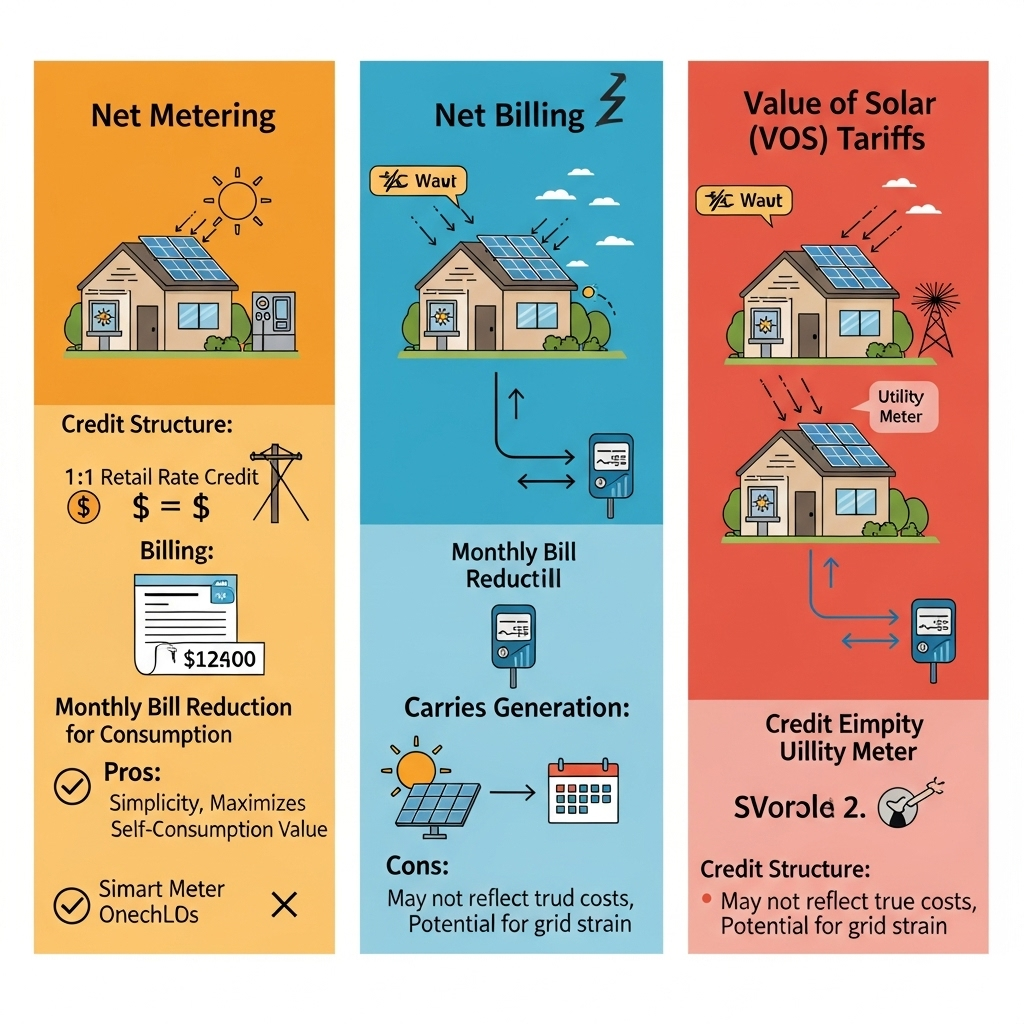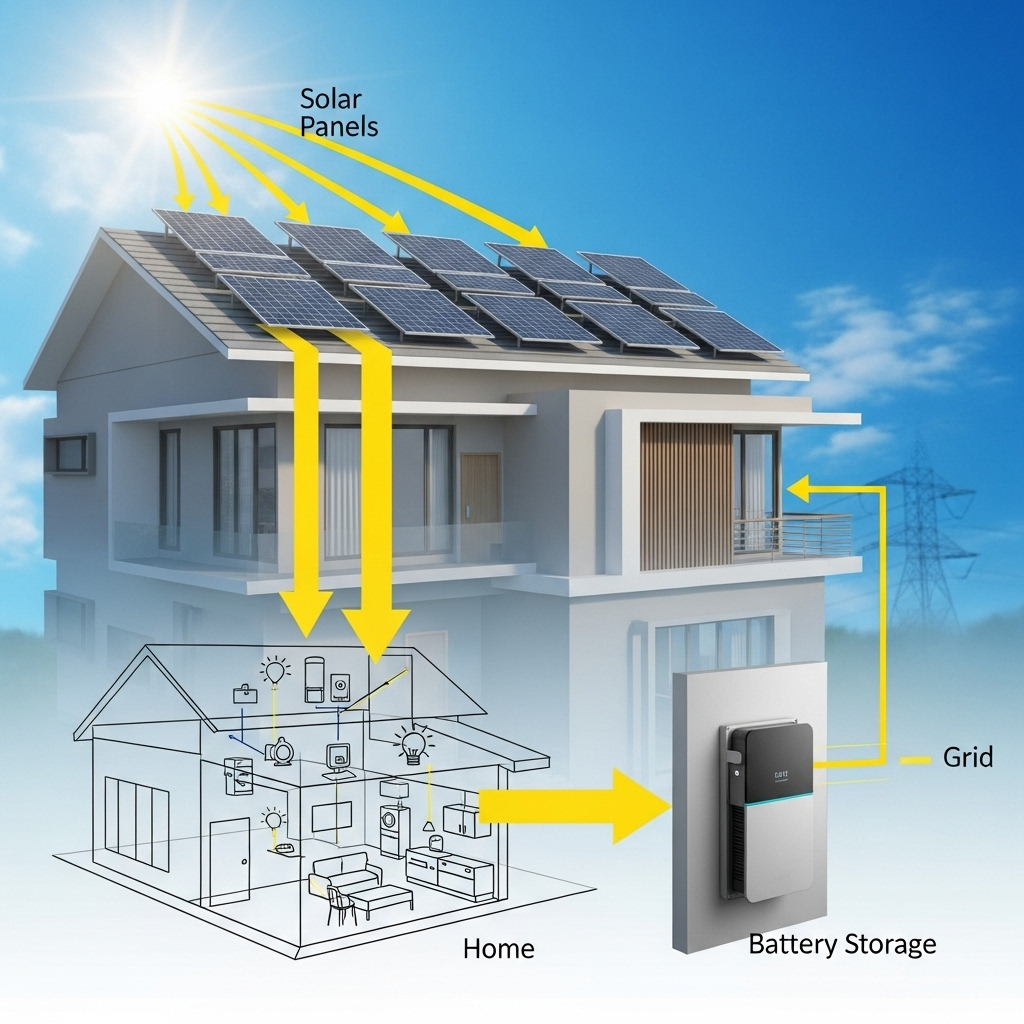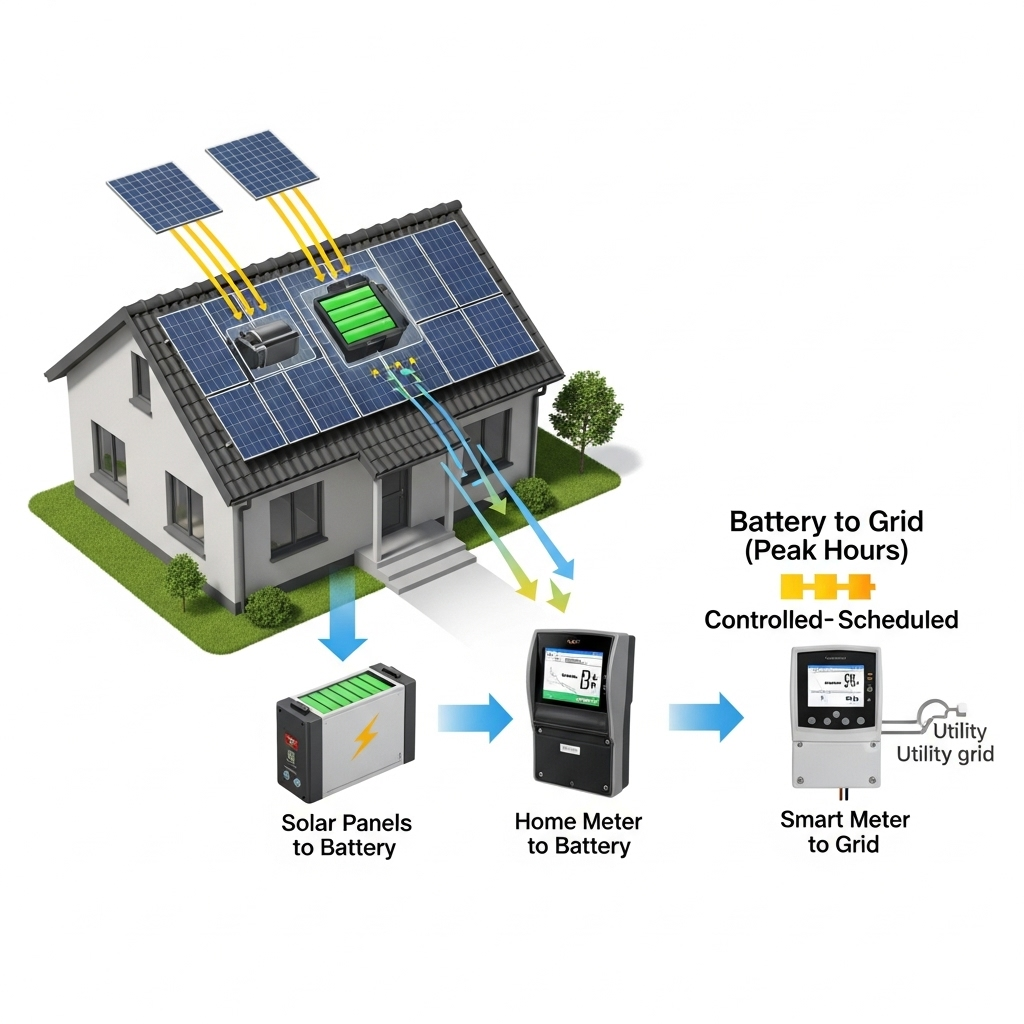The way solar system owners are compensated for the extra electricity they send to the grid is undergoing a significant transformation. Traditional net metering, with its simple one-for-one credit system, is gradually being replaced by more complex structures like Net Billing and Value of Solar (VOS) tariffs. Understanding these new export compensation rules is vital for anyone considering a solar investment. This outlook provides a clear picture of the policy landscape in key markets as we approach 2025 and explains how these changes affect the value of solar energy.
The Shift Away from Traditional Net Metering
For years, net metering was the standard for residential solar. It allowed homeowners to receive a credit for every kilowatt-hour (kWh) of excess solar energy they exported to the grid, equal to the price they paid for electricity from the utility. This model was instrumental in driving early solar adoption. However, as more solar systems came online, utilities and regulators began to address concerns about grid stability and cost-shifting, leading to the development of new compensation models.
Net Billing Explained
Net billing uncouples the price of imported electricity from the credit rate for exported electricity. Under this structure, you still pay the full retail rate for any electricity you draw from the grid. However, the energy you export is credited at a lower rate, often based on the wholesale price of electricity or the utility's 'avoided cost'—the amount it would have cost them to generate that power themselves. This change directly impacts the financial calculations for a solar system, making self-consumption of solar energy more valuable.
Understanding Value of Solar (VOS) Tariffs
A Value of Solar (VOS) tariff is a more dynamic and granular approach. Instead of a fixed export rate, it calculates the value of solar energy based on multiple factors. These can include the wholesale energy price, avoided grid infrastructure costs, and environmental benefits. As noted in a report by the International Energy Agency (IEA), Minnesota was an early implementer of VOS tariffs, which set specific rates for excess solar generation that can reflect its true value to the grid at the time of production. This rate can change based on time of day and season, rewarding homeowners who supply power during peak demand periods.
Global Policy Trends Heading into 2025
Governments worldwide are adjusting their policies to balance renewable energy growth with grid economics. The World Energy Investment 2023 report highlights that new policies are providing a significant boost to low-emission power, but the specifics of compensation are becoming more nuanced.
North America: A State-by-State Transition
In the United States, solar compensation policies are highly fragmented. California, a long-time solar leader, moved to a net billing structure (NEM 3.0) which significantly reduced export credit rates. This has accelerated the adoption of home battery storage. Other states like Arizona and Hawaii have also ended their traditional net metering schemes for new customers, creating a clear trend toward models that incentivize self-consumption. New York is also developing a new remuneration scheme, moving away from its previous net metering caps. This patchwork of regulations makes it important for potential solar owners to research their local utility's specific rules.
Europe: A Push for Self-Consumption and Grid Stability
The European Union's REPowerEU plan aims to rapidly increase renewable energy generation. To manage this influx, many member states are transitioning to compensation schemes that encourage solar owners to use their generated power on-site. This often involves time-of-use rates and lower feed-in tariffs for exported energy. The goal is to reduce strain on the grid during peak solar production hours (mid-day) and encourage energy use or storage during those times. This aligns with a broader strategy to create a more resilient and decentralized energy system.
Asia-Pacific: Evolving Markets
In mature markets like Australia, feed-in tariffs have long operated as a form of net billing, with export rates being much lower than retail electricity prices. In rapidly growing markets like India and across Southeast Asia, policies are being designed from the ground up to incorporate these modern principles. For instance, as part of its energy transition, Indonesia has set ambitious renewable energy targets that will likely be supported by policies favoring on-site consumption and grid support, rather than simple export models.
Adapting to New Tariffs: The Central Role of Energy Storage
The global shift to net billing and VOS tariffs fundamentally changes the strategy for maximizing a solar investment. The focus is no longer on maximizing exports, but on maximizing self-consumption. This is where energy storage becomes a game-changer.
How Storage Maximizes Your Solar Investment
With a home battery system, such as one using reliable Lithium Iron Phosphate (LiFePO4) cells, you can store the excess solar energy you generate during the day instead of exporting it for a low credit. You can then use this stored energy during the evening and night, avoiding the need to purchase expensive electricity from the grid. This dramatically increases your energy independence and insulates you from fluctuating utility rates and policy changes.
| Scenario | Annual Export (kWh) | Export Credit Rate ($/kWh) | Annual Export Value | Impact on Savings |
|---|---|---|---|---|
| Net Metering | 4,000 | $0.25 (Retail Rate) | $1,000 | High |
| Net Billing (No Storage) | 4,000 | $0.05 (Avoided Cost) | $200 | Reduced |
| Net Billing (With Storage) | 1,000 | $0.05 (Avoided Cost) | $50 | Maximized (3,000 kWh self-consumed, avoiding $750 in grid purchases) |
Note: Values are illustrative and vary based on location, consumption, and system size.
Designing Your System for Self-Consumption
In a net billing environment, simply installing the largest possible solar array is not always the most effective strategy. A smarter approach is to size your system based on your actual energy consumption patterns. A hybrid inverter paired with a correctly sized battery allows you to intelligently manage your energy flows. To do this effectively, you need a solid grasp of how your system operates. Understanding the key metrics outlined in resources like the Ultimate Reference for Solar Storage Performance is crucial for evaluating how well your battery system will perform and for ensuring you are truly maximizing your self-consumption potential.
Your Path Forward in the New Solar Landscape
The transition to net billing and VOS tariffs represents a maturation of the residential solar market. While these changes require a shift in thinking, they do not diminish the long-term value of generating your own clean energy. Instead, they highlight the integrated nature of modern energy solutions. By pairing solar panels with a high-performance energy storage system, you can adapt to the new rules, reduce your reliance on the grid, and take control of your energy future. The focus is now on smart system design that prioritizes using the power you produce.
Disclaimer: This article is for informational purposes only and does not constitute financial or legal advice. Solar compensation policies are complex and subject to change. Consult with a qualified solar installer and a financial advisor to understand the specific regulations and incentives available in your area.
Frequently Asked Questions
What is the main difference between net metering and net billing?
The key difference is the credit rate for exported energy. With net metering, the credit rate is typically the same as the retail electricity rate (a 1:1 swap). With net billing, the credit for exported energy is lower than the rate you pay for electricity you import from the grid.
Will my existing net metering agreement be affected by new policies?
In many regions, existing net metering customers are 'grandfathered' in, meaning their original agreement terms are honored for a set period (e.g., 15-20 years). However, new policies like net billing typically apply to all new solar installations after a certain date. It is critical to check your local utility's specific rules.
Is solar still a good investment with net billing?
Yes, but the financial calculation changes. The return on investment is now maximized by pairing solar panels with a battery storage system. This allows you to store excess energy for later use (self-consumption) instead of exporting it for a low credit, which significantly increases savings.
How does a Value of Solar (VOS) tariff work?
A VOS tariff attempts to calculate the true value of your exported solar power to the grid at any given moment. It considers factors like the wholesale cost of energy, avoided transmission and distribution costs, and environmental benefits. The rate you receive can vary by time of day and season, often paying more during peak demand hours.
What size battery do I need for my home?
The ideal battery size depends on your daily energy consumption (especially during evening hours), the size of your solar PV system, and your goals (e.g., maximizing savings vs. having backup power). A professional installer can perform an energy audit to recommend the optimal size for your specific needs.





Leave a comment
All comments are moderated before being published.
This site is protected by hCaptcha and the hCaptcha Privacy Policy and Terms of Service apply.